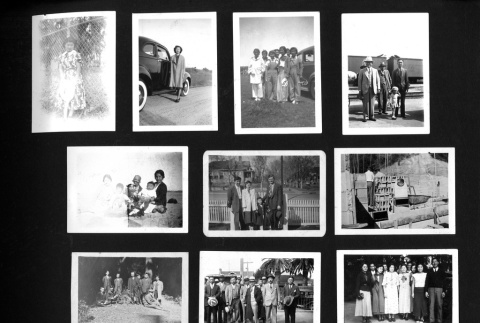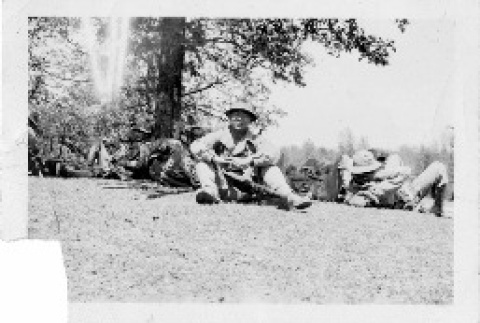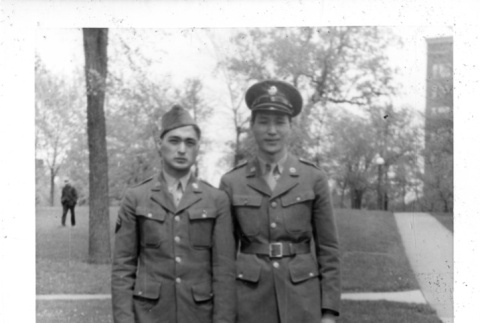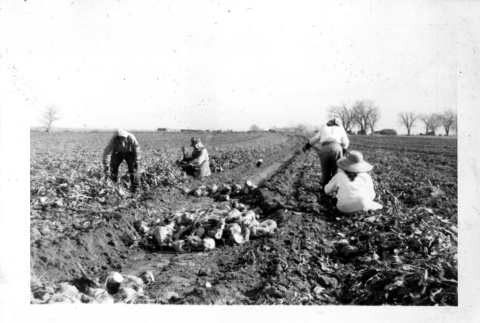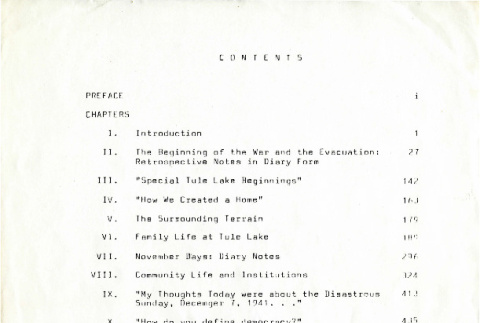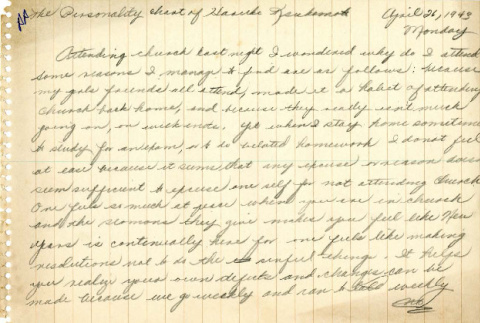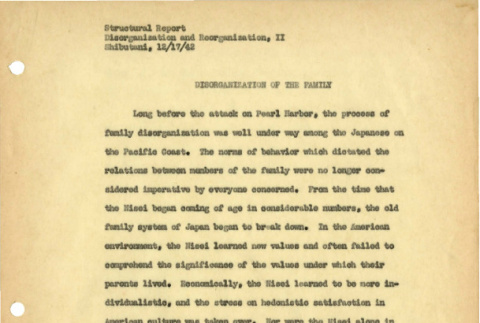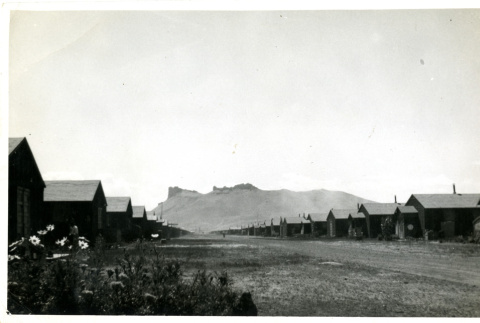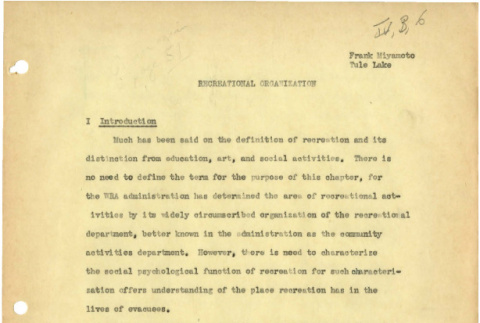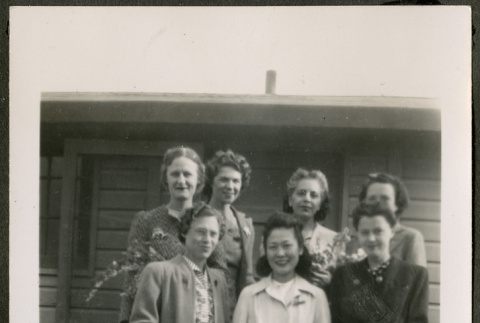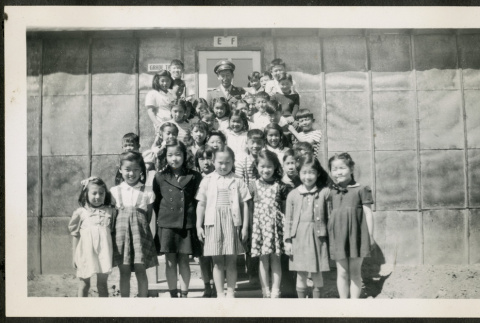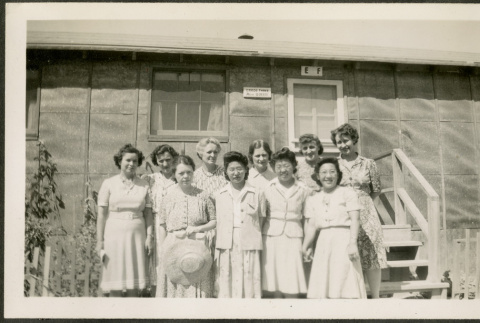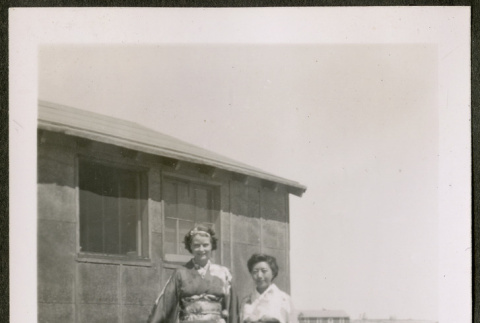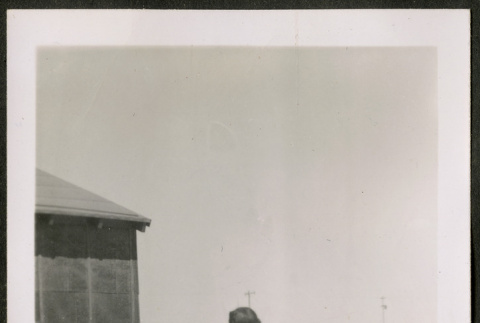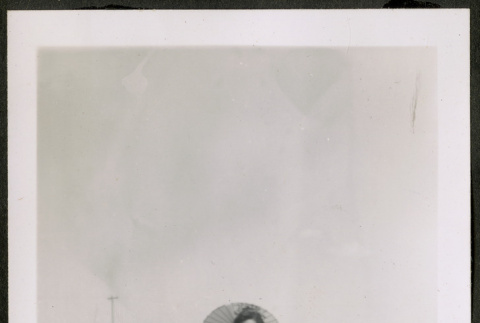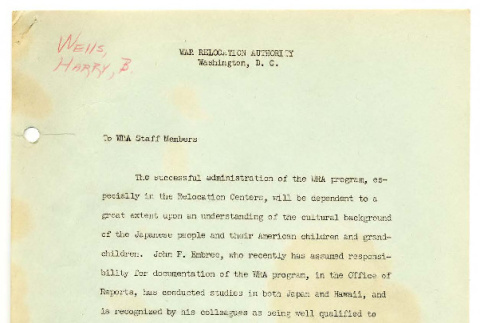Nisei
The Nisei (second generation) felt the pull of two cultures. American born, attending public schools, and influenced by American popular culture, they shared the same idols, favorite songs and sports heroes as most other children of their generation. Wanting to fit in, many Nisei with Japanese first names dropped them for Western ones that their non-Japanese friends could easily pronounce. Yet, most grew up in Japanese neighborhoods, and their parents taught them the customs and values of the old country.
Identity and values
(200)
Nisei
(2535)
Related articles from the
Densho Encyclopedia :
Nisei
2535 items
2535 items
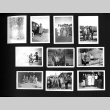
img
Japanese family (ddr-csujad-25-311)
A page from a photo album including Japanese family photographs. Pasted on the page are family photographs including Japanese men, women, and children. Also includes a Caucasian family. One of the photographs captures a group of Japanese men along with a female child standing in front of a "Pacific Fruit Express" railroad refrigerator car. The photographs …

img
Toshikuni Taenaka in US Army combat uniform (ddr-csujad-25-60)
A photograph of Toshikuni Taenaka, a Japanese American Nisei/Kibei soldier, in US Army combat uniform, resting with other soldiers. Inscription on the back of the photograph reads: 4-42, me. See this object in the California State Universities Japanese American Digitization project site: jia_08_01_002

img
Toshikuni Taenaka in US Army uniform (ddr-csujad-25-71)
A photograph of Toshikuni Taenaka, a Japanese American Nisei/Kibei soldier, in US Army uniform with Private First Class insignia on the arm and a gas mask. He poses, holding a gas mask and standing in front of the house where his parents most likely reside in Brighton, Colorado. See this object in the California State Universities …

img
Japanese American soldiers in US Army uniform (ddr-csujad-25-110)
A photograph of Japanese American soldiers in US Army uniform. They pose standing outside. The photograph is probably taken in Camp Savage, Minnesota. See this object in the California State Universities Japanese American Digitization project site: jia_08_01_052
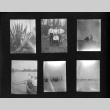
img
Japanese family (ddr-csujad-25-294)
A page from a photo album including Japanese family photographs. Some photographs are taken at the beach. One of the photographs depicts a Japanese man riding a horse. The photographs are taken in the early 1900s. Location is unknown. See this object in the California State Universities Japanese American Digitization project site: jia_10_01_002
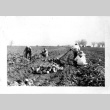
img
Taenaka family in a farm (ddr-csujad-25-91)
A photograph of the Taenaka family in a farm, Brighton, Colorado. Includes Tamesaburo Taenaka, Kamie Taenaka, Ukichi Taenaka [?], and Yaeko Taenaka [?], harvesting sugar beets in McMorrow's farm. The same image is found in item: ucsb_jia_0081. See this object in the California State Universities Japanese American Digitization project site: jia_08_01_033
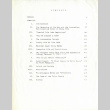
doc
Tule Lake monograph (ddr-csujad-26-1)
Unpublished manuscript includes a collection of diary entries, letters, and essays written by school students incarcerated at the Tule Lake camp and collected through the Japanese American Evacuation and Resettlement Study (JERS). The writings include first-person descriptions of travel to the Tule Lake camp, adapting to camp, limitations of camp, day-to-day camp life, family life, community …
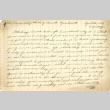
doc
Chapter 6 and 7 personality cards (ddr-csujad-26-34)
Journal entries written by high school students discussing their observations and perspectives on a variety of topics including living in barracks, block noise, lack of privacy, mess hall dining, nosy neighbors, jobs, leisure time, sports, movies, church attendance, the Young Buddhist Association (YBA), family dynamics, social changes, dating, and rumors. Each entry includes the full date …
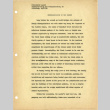
doc
Structural report, disorganization and reorganization, II: disorganization of the family (ddr-csujad-26-19)
Essay on family instability and the breakdown of traditional Japanese familial roles after incarceration including descriptions of incidents at Tule Lake which is used to further the author's agenda. Report compiled as a portion of the Japanese American Evacuation and Resettlement Study (JERS). See this object in the California State Universities Japanese American Digitization project site: …
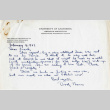
doc
University of California, evacuation and settlement study: case history I (ddr-csujad-26-26)
Correspondence regarding a profile of incarceree Harry Osaka written by Robert Spencer. The profile was taken during a trip to Fresno for Harry's mother's funeral with Spencer as the escort and includes Harry's life and family story, farm business before incarceration, religious practices, holiday practices, description of funeral. Profile included as part of the Japanese American …
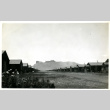
img
View of the camp showing Castle Rock (ddr-csujad-26-102)
Photo of camp buildings and road down the middle backed by hilly landscape. Caption on back of photo reads, "View of the camp showing Castle Rock. A Nisei objected to this picture because the daisies in the corner relieve the dusty monotony of the camp." From photo album of Robert Billigmeier. See this object in the …
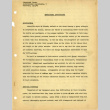
doc
Structural report, institutional adjustments, V: educational institutions (ddr-csujad-26-20)
Essay observing education levels, types of students, and establishment of education programs at Tule Lake for English speaking students. Includes descriptions of programs for various age groups including nursery, primary, secondary, adult education, college and the Student Relocation Council. Report compiled as a portion of the Japanese American Evacuation and Resettlement Study (JERS). See this object …

doc
Structural report, disorganization and reorganization, IV: social reorganization in Tule Lake (ddr-csujad-26-21)
Manuscript evaluating potential behavior patterns and social organization among incarcerees at Tule Lake including leadership roles, planning boards, efforts to curb juvenile delinquency and "Nisei apathy." Report compiled as a portion of the Japanese American Evacuation and Resettlement Study (JERS). See this object in the California State Universities Japanese American Digitization project site: mei_02_28_001

doc
Chapter 2, 3, 4, 5 personality cards (ddr-csujad-26-32)
Journal entries written by high school students discussing their observations and perspectives on a variety of topics including weather, social interactions, barracks noise, the desire to leave camp, prospect of discrimination, reflections on "one year since 'evacuation,'" and the journey to camp. Each entry includes the full date and student name. The entries were part of …
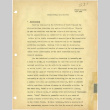
doc
Recreational organization (ddr-csujad-26-10)
Report detailing the establishment of a recreation and community activities department including its organization, activities planning, personnel problems and conflicts, issues with structure and equipment, and a structural diagram of the community activities section. The report focuses on the place of recreation in the lives of incarcerees and the differences between Issei and Nisei leading to …

doc
Recreational activities in the Gila community (ddr-csujad-26-28)
Report detailing the establishment of the Community Activities Department to organize sports, dances, a library, movies, talent shows, drama performances, and lectures by the National Park Service about the desert environs. Includes description of issues with the installation of organized recreation due to lack of funding and personnel issues. Report compiled as a portion of the …
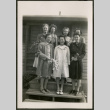
img
Group of women at Minidoka incarceration camp (ddr-csujad-32-12)
Group photograph of women, one is Japanese American and others are Caucasian (possibly teachers), at the Minidoka incarceration camp. Some of them are holding a bouquet of flowers. This photo is featured on page 6 of the Minidoka Incarceration Camp Photograph Album (csudh_ben_001). See this object in the California State Universities Japanese American Digitization project site: …

img
Group of children with Ben Kuroki (ddr-csujad-32-22)
Group photograph of children with Ben Kuroki in military uniform at the Minidoka incarceration camp. Photo featured on page 9 of the Minidoka Incarceration Camp Photograph Album (csudh_ben_001). See this object in the California State Universities Japanese American Digitization project site: ben_01_001_010_033
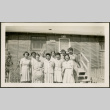
img
Group of women at Minidoka incarceration camp (ddr-csujad-32-11)
Group photograph of women standing in front of Miss Queen's grade three classroom at the Minidoka incarceration camp. Photo featured on page 6 of the Minidoka Incarceration Camp Photograph Album (csudh_ben_001). See this object in the California State Universities Japanese American Digitization project site: ben_01_001_007_020
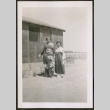
img
Women at the Minidoka camp (ddr-csujad-32-30)
Photograph of two women standing outside a camp barrack. One of the women is Caucasian, probably a teacher, and wearing a kimono. The other is Japanese American and also wearing a kimono. She is possibly Madame Fujima Kansuma's dance student. Photo featured on page 16 of the Minidoka Incarceration Camp Photograph Album (csudh_ben_001). See this object …
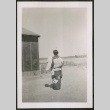
img
Woman in kimono (ddr-csujad-32-32)
Photograph of a woman wearing a kimono and holding an umbrella. She is possibly Madame Fujima Kansuma's dance student. Photo featured on page 17 of the Minidoka Incarceration Camp Photograph Album (csudh_ben_001). See this object in the California State Universities Japanese American Digitization project site: ben_01_001_018_058
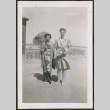
img
Two women, one woman wearing a kimono (ddr-csujad-32-31)
Photograph of two women standing outside. One is Caucasian (possibly a teacher) and the other is Japanese American who is wearing a kimono and holding an umbrella. She is possibly Madame Fujima Kansuma's dance student. Photo featured on page 16 of the Minidoka Incarceration Camp Photograph Album (csudh_ben_001). See this object in the California State Universities …
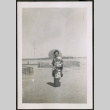
img
Woman wearing kimono (ddr-csujad-32-33)
Photograph of a woman wearing a kimono and holding an umbrella. She is possibly Madame Fujima Kansuma's dance student. Photo featured on page 17 of the Minidoka Incarceration Camp Photograph Album (csudh_ben_001). See this object in the California State Universities Japanese American Digitization project site: ben_01_001_018_059
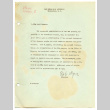
doc
Dealing with Japanese-Americans by John F. Embree, Documents Section, Office of Reports (ddr-csujad-48-131)
Short report from WRA Documents Section leader John F. Embree on recommended attitudes, suggestions, and practices while interacting with incarcerated Japanese Americans. According to Embree, race is hereditary while culture is acquired, and Caucasians should refrain from making stereotypical images of "Japanese types." Embree describes the differences in culture and attitudes including questions of loyalty between …

doc
Letter from Otis D. Richardson, Chair of English Department, Los Angeles City College, March 21, 1943 (ddr-csujad-48-56)
Letter from Otis Richardson highlighting the need to educating the Nisei about conforming to cultural norms. He discusses the unwillingness of Nisei and Kibei to educate themselves about the current issue regarding mass evacuation and the need for Americanization of all Japanese. He concludes the letter with "A Social Plan for Minority Groups." Richardson provides a …
